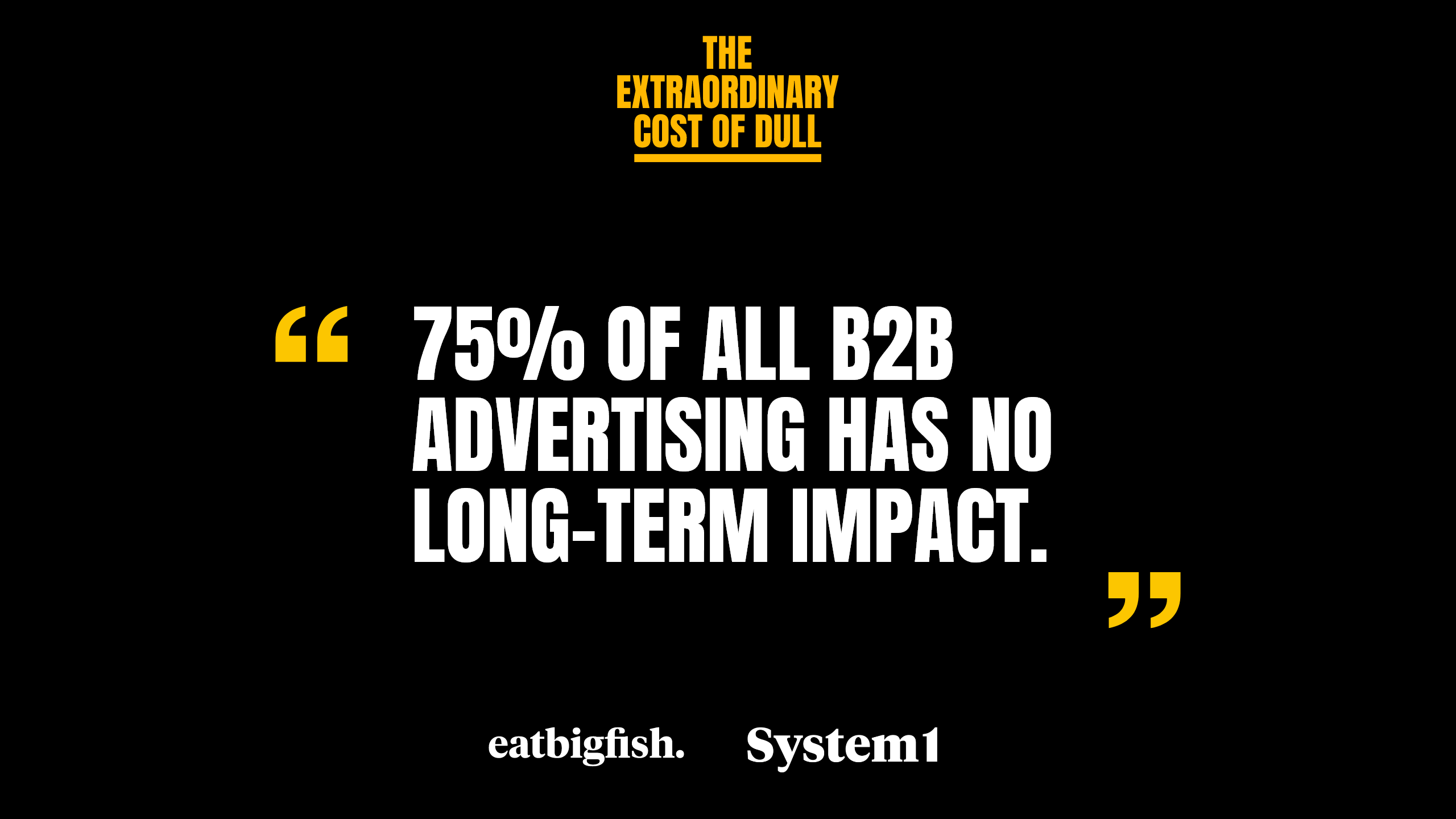Defeating Dullness in B2B Advertising
According to Paul Dyson’s 2023 analysis on advertising profitability, creative quality is the second strongest profitability multiplier behind brand size, making it the top factor that brands can control.
Yet, on average, 75% of all B2B advertising has no long-term commercial impact. Let that sink in. Just 1 in 4 B2B ads drive profit gain and market share growth.
Why?
Let’s explore the ‘dullness’ of B2B further…
B2B’s Biggest Problem: Neutrality
Of course, not every B2B ad fails on long-term brand building, but the vast majority of them underperform.
This is because they are often rational, pushing a sale to people who may not yet be in the market, focused on features, benefits and pricing, and creatively left brained, as our very own Orlando Wood would say.
In fact, B2B ads are often what we at System1 would call ‘dull’ – per our collaboration with Peter Field and Adam Morgan on The Extraordinary Cost of Dull report.
B2B advertising’s biggest problem is that it typically doesn’t spark any emotion among audiences, let alone a positive emotional response. And without any feeling, people aren’t compelled to act once they are ready to buy.
System1’s Jon Evans, Peter Field and Adam Morgan further highlighted in their Cost of Dull research just how detrimental Neutrality, or a lack of any emotional response, is to B2B advertising. As Neutrality rises, it doesn’t do much to diminish negative feelings. Instead, it cuts into the levels of positive emotions of Happiness and Surprise.
Often, B2B brands play it safe, believing that taking creative risks is well…too risky. But ‘safe’ often translates to ‘boring’ in the eyes of consumers. Making them feel something is actually much more advantageous than making them feel nothing. As the chart shows, Neutrality negatively impacts the ability to elicit the most effective positive emotions. The ones that support long-term brand building. That build memory structures, so 6-12 months from now, you are more likely to differentiate your brand and close the sale.
Getting Beyond the “What About Me/B2B?” Mentality
Many B2B marketers ask “Is this applicable to my sector and my customers?” when faced with new marketing research.
In fact, it’s one of professor and consultant Mark Ritson’s most dreaded questions, one he has encountered thousands of times over the course of his illustrious career. It has even inspired him to dedicate a column to why marketers should stop asking if marketing theory and strategy is applicable to B2B.
The principles that make B2C advertising effective also apply to B2B!
Thus, it’s in B2B marketers’ best interests to drop the “What about me?” mentality and instead reframe their thinking to “How can I best apply this to me/B2B?”.
It’s also important to remember that while consumer brand campaigns often look vastly different from B2B campaigns, they still suffer from large gaps in creative effectiveness. In fact, just 1% of ads in System1’s database of 150,000 ads achieve the highest effectiveness rating of 5-Stars. The average US ad sits in the 2-Star range. Even Super Bowl ads have historically had trouble breaking free from the 2-Star average!
So, B2B marketers and B2C marketers are more alike than they are different. They fact the same struggles when trying to entertain and grow their brands.
Now to the best part – how can marketers actually defeat dullness and achieve commercial success?
5 Questions to Ask Yourself: The Anti-Dull Dial
In the Cost of Dull report, the authors introduce the Anti-Dull Dial, a way to overcome the tendency for advertising (not just B2B, but B2C too!) to be dull. There are 5 key questions marketers should ask themselves:
1. Are we meeting them [the audience] where they care, and speaking to them in their language? People find ads interesting when the ads are about things they care about too, and aren’t full of business speak or jargon. This can be an especially common pitfall in B2B ads.
2. Are we using the real bar to judge what’s interesting, or some invented one of our own? As marketers we can’t lie to ourselves, and pretend something’s going to interest our audience when it really won’t. Fortunately, there are ways of measuring these things – testing with System1’s Test Your Ad platform, for example, will give a fast, objective measure of how interesting consumers find an ad.
3. Are we showing real distinctiveness and character? Does your ad look and feel distinctive, and distinctively you? That might mean a recurring brand character or Fluent Device, or other assets that quickly and easily communicate your brand to audiences.
4. Are we using emotion, drama and storytelling? Nothing beats dullness more thoroughly than an entertaining ad – particularly, as we’ll see, a funny one.
5. Are we denying one of their key assumptions, and surprising them? Happiness isn’t the only beneficial emotion for advertising – Surprise plays a big part too, and dullness kills surprise. So it’s worth deliberately aiming to go against some audience expectations and give them something that’ll make people sit up, not snooze.
Real-life Inspiration of B2B Success
Straight from Cannes Lions 2025, for more about how to approach B2B advertising, hear from Lucia Ying at Amazon Ads, who notes that “in reality, B2B and B2C aren’t that different.”
Create with Confidence
Want to develop B2B or B2C ads with greater confidence that you’ll actually engage and entertain your audience? With System1’s Test Your Ad platform, you can test with nat rep and custom audiences before launching your creative to predict its commercial potential. Plus, our Guidance teams can propose recommendations that help to further improve short-term sales effects and long-term brand effects.
Contact our team for a demo of the Test Your Ad platform today!


